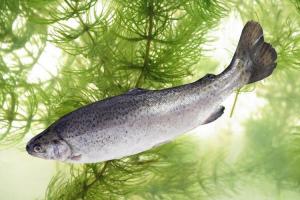Ronald Faber: Aquaculture and the algae advantage
The following is an edited transcript of Tom Martin’s interview with Ronald Faber of Coppens International, an Alltech Company. Ronald has since been promoted to managing director.
Click below to hear the full interview: https://soundcloud.com/alltech-1/034-aquaculture-and-the-algae-advantage-ronald-faber
Tom: Coppens International, a leading international aquatic feed solutions company in the Netherlands, was acquired by Alltech in 2016. The company exports quality aquatic feed to more than 60 countries worldwide. Ronald Faber is its chief commercial officer. We welcome you here today, Ronald.
Ronald: Thank you very much for the invitation.
Tom: Glad to have you. Tell us about Coppens’ product line, if you will. What are your specialties?
Ronald: Our product line is very broad. We make a differentiation between our product lines: We have different feeds for the aquaculture industry — producing feed for fish, to grow fish. And, separately, we have a product line for hobby feeds.
Tom: And it’s a wide variety of fish: ornamental, specialty and even bait feeds.
Ronald: Correct. Even on bait, we have a superior product line, which we’re exporting to 60 countries worldwide.
Tom: What species of fish would you consider your target market?
Ronald: Do you mean for industrial feeds or for hobby feeds?
Tom:Let’s begin with industrial.
Ronald: For industrial, we have a very strong position in more advanced species — high-value species such as eel, trout and salmon. We are less active in the more budget-type of species such as tilapia.
Tom: And then on the ornamental side?
Ronald: For ornamental, we’re targeting high-priced species such as koi — they sell for thousands of euros per head — and other hobby species such as goldfish and shubunkins. We have specialized diets for ornamental and hobby fish.
Tom: What are the particular challenges you face with each of those divisions? Let’s start with industry again.
Ronald: Sure. The biggest challenge for us is, of course, the fish in-fish out ratio. We still use fishmeal from wild-caught fish to make our diets.
Tom: And then on the ornamental side? Pretty much the same?
Ronald: It’s similar, but on the ornamental side, the challenge is following the fast-changing requirements of the consumers.
Tom: You spent a couple of years working with fish and shrimp feed companies in Southeast Asia, India and, I believe, Indonesia. Is that correct?
Ronald: That’s correct. That’s right.
Tom: What were the most important takeaways from those experiences?
Ronald: Personally, of course, it was a very challenging period of my life being in a new culture. But the industry is developing so quickly in these countries that, in the Western world, we’re really left behind.
Tom: Is it fair to say that aquaculture is booming in Vietnam? And if it is, does Coppens participate in that?
Ronald: It’s definitely booming, and it’s not only booming in Vietnam. I was speaking to people from India yesterday, and I was really surprised by the huge volume produced there. So, it’s growing extremely fast all over the region.
Tom: And what species of fish are being farmed?
Ronald: Traditionally, it’s been shrimp, which has a high profit margin. But they also farm other fish species that are more mainstream, such as tilapia and pangasius.
Tom: What are some important challenges faced by aqua producers that might actually be an opportunity?
Ronald: One of the challenges is, I think, with sustainability. In the past, the industry hasn’t been very focused on sustainability, but rather on production.
Tom: How does Coppens benefit by integrating with Alltech’s algae production?
Ronald: That came to us at just the right time, definitely. We had been looking for new ways to develop our feeds. We spent a couple of years on projects that would allow us to convert to a zero fish in-fish out process, meaning we wouldn’t use fishmeal or fish oil. We had come a long way, but we were missing that last piece of the puzzle. Alltech brought us the last piece of the puzzle.
Tom: And what was that?
Ronald: That was, as you mentioned, the algae. Algae is a fantastic ingredient. It’s a sustainable source of DHA, which is required in the diets of many fish species. Normally, you would have to get DHA from fish oil, but we can now get it from algae.
Tom: There are many tens of thousands of species of algae. Are there any particular algae you focus on?
Ronald: Yes. We focus particularly on that which provide a high level of DHA in the diet.
Tom: What industry trends are you watching closely these days?
Ronald: The most important development is consolidation in the industry. Farms all around the world are becoming bigger and bigger and involve more technology.
Tom: When you think about it, how does your work affect the average consumer’s dinner table? What’s the consumer end of what you do? You’re on the feeding end, so the nutrition of the aquatic stock is important to you. How does that translate out on the other end to good food?
Ronald: Good food is reliable food. It’s tasty. It’s healthy. So, in our (feed) recipes, we always take care of these three aspects so that we transfer them from the feed to the final product.
Tom: You mentioned earlier that your experiences were wonderful in Southeast Asia and India. What do you most enjoy about your work besides that?
Ronald: I enjoy visiting different cultures; different countries. Fish farming is always done in fantastic places. It’s not done in an industrial way. Very often you are in very natural, very green environments. That makes it interesting.
Tom: Ronald Faber, chief commercial officer of Coppens International. Thank you so much for chatting with us.
Ronald: Thank you also.
Ronald Faber spoke at ONE: The Alltech Ideas Conference (ONE17). To hear his presentation on RAS farming and more talks from the conference, sign up for the Alltech Idea Lab.


